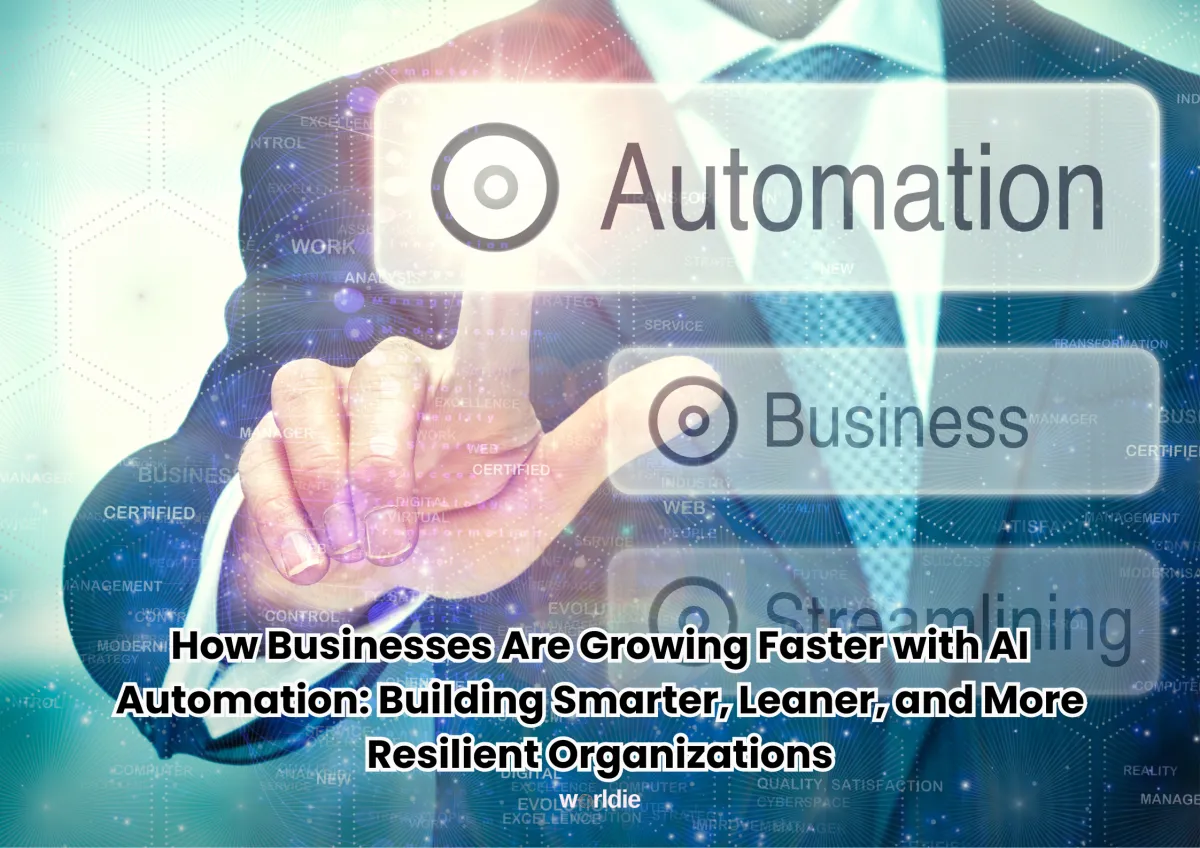
How Businesses Are Growing Faster with AI Automation: Building Smarter, Leaner, and More Resilient Organizations
Artificial intelligence has evolved from an experimental concept into the primary growth driver for the modern economy. Understanding how businesses are growing faster with AI automation means recognizing that the competitive advantage of 2025 and beyond will belong to organizations that combine human creativity with machine intelligence. The companies leading their industries are not just adopting AI; they are embedding automation into the fabric of their operations to create scalable, intelligent, and resilient growth systems.
Worldie AI plays a pivotal role in helping businesses make this leap — from manual, fragmented processes to adaptive, data-driven infrastructures that can think, learn, and evolve.
The Meaning of AI Automation in Business Growth
AI automation is the fusion of artificial intelligence and automated workflows to create systems that make decisions, learn from outcomes, and continuously optimize performance. Traditional automation relies on rules — step-by-step instructions defined by humans. AI automation, on the other hand, uses data-driven intelligence to predict, adjust, and act autonomously.
Imagine a business system that anticipates customer behavior, manages inventory with precision, and adapts marketing campaigns in real time. That is AI automation in action — not just executing tasks, but understanding why they matter and how to make them better over time.
When companies integrate AI automation, they move beyond process efficiency and into strategic acceleration. They stop reacting and start predicting. The result is faster decision-making, reduced operational waste, and scalable growth that compounds with every data interaction.
Where Traditional Growth Models Fall Behind
For decades, businesses have depended on manual labor, static reports, and human oversight to manage growth. These models worked when markets moved slowly, but they’re now struggling to keep up with the rapid pace of digital change. Teams spend hours entering data, tracking analytics, or manually managing customer engagement — tasks that don’t directly drive innovation.
The bottleneck isn’t skill; it’s structure. Even the most talented teams can’t scale human judgment at the same rate machines can analyze and act. The gap between what businesses could do and what they actually do widens each day without automation. Companies that fail to evolve risk becoming data-rich but decision-poor — sitting on information they can’t fully use.
AI automation bridges this gap by replacing reaction with foresight. It learns patterns humans might miss, identifies inefficiencies that slow revenue, and builds systems that improve continuously without demanding more time or manpower.
The New Revenue Model: Intelligence as Infrastructure
AI doesn’t just improve efficiency; it redefines how companies grow and make money. When automation is powered by intelligence, every part of the business becomes a growth engine.
Marketing teams no longer rely on assumptions; they use predictive models to anticipate demand and personalize campaigns. Sales operations move beyond manual tracking to automated lead scoring that identifies high-value opportunities before competitors do. Supply chains become self-regulating, adjusting production or delivery schedules based on real-time data.
AI transforms revenue from a linear process into a dynamic ecosystem — one that scales without proportionate increases in cost. Businesses achieve more with less, not by overworking teams, but by empowering them with intelligent tools that work around the clock.
Why Businesses with AI Automation Grow Faster
Companies growing faster with AI automation share one defining trait — they operate as learning systems. Every data point, customer interaction, or operational outcome feeds intelligence back into their decision-making loops. Over time, these systems become more accurate, more efficient, and more aligned with business goals.
AI doesn’t tire, and it doesn’t stop learning. That creates a compounding effect — the longer it runs, the smarter it becomes. A sales forecasting model refines itself after each campaign. A support chatbot becomes more natural with every conversation. The result is not just faster growth, but growth that sustains itself through adaptability and intelligence.
AI Across Industries: Practical Growth in Action
The transformative impact of AI automation is visible across industries. Retail companies use AI to predict buying behavior, personalize product recommendations, and optimize pricing. In finance, automation systems analyze millions of transactions to detect fraud or assess creditworthiness in seconds. Healthcare organizations use AI to assist doctors, manage appointments, and process insurance claims without human intervention.
Manufacturing businesses are using AI to monitor production lines, predict equipment failures before they occur, and reduce downtime. Even creative industries — marketing, design, and media — are now integrating AI tools that generate content, analyze audience engagement, and deliver insights impossible to achieve manually.
Each of these use cases highlights the same principle: AI enables speed, precision, and scalability without sacrificing quality.
The Worldie AI Approach: From Design to Deployment
Worldie AI follows a structured approach to building and releasing AI automation systems that deliver measurable results. It begins with design, where the team identifies key business challenges, data opportunities, and areas where automation can create the greatest impact. This phase involves aligning AI models with the company’s existing workflows and strategic objectives.
Next is the build stage — the engineering of intelligent systems. Worldie AI develops tailored models trained on relevant datasets, ensuring that automation is both accurate and context-aware. The focus is on building systems that can adapt as the business evolves.
Finally comes the release — a seamless integration of the AI system into live operations. Worldie AI ensures these systems are continuously monitored, refined, and scaled, transforming automation into a living component of the organization.
This full-cycle approach guarantees that AI isn’t just installed — it’s embedded into the company’s long-term growth structure.
Breaking Down Operational Friction
Every business struggles with friction — slow approvals, manual reporting, repetitive tasks, and disjointed communication. These inefficiencies create invisible losses that compound over time. AI automation targets these weak points with precision.
Instead of spending hours on routine processes, employees can delegate them to intelligent systems that work continuously and accurately. Marketing teams can automate campaign adjustments in real time. HR departments can streamline hiring and onboarding through smart automation. Finance teams can predict cash flow variations instantly.
Reducing friction doesn’t just make work faster; it makes it smarter. Companies free up human creativity for innovation, while AI handles the repetitive backbone of execution.
Blending Human and Artificial Intelligence
The best-performing organizations understand that AI is not here to replace people; it’s here to extend them. Human insight remains essential in areas like ethics, creativity, and strategic planning. AI enhances those skills by providing the data-driven foundation that supports better decisions.
Think of AI as a digital partner that manages the details, while humans guide the direction. When both work in harmony, businesses achieve what neither could alone — consistent innovation powered by precise execution.
Overcoming Challenges in AI Adoption
Implementing AI automation is not without challenges. Many organizations struggle with data readiness, cultural resistance, or uncertainty about where to begin. Worldie AI addresses these concerns by providing tailored strategies and guided implementation.
It starts with data preparation — cleaning, organizing, and aligning datasets to ensure the AI system can learn effectively. Next, it focuses on employee onboarding, training teams to collaborate with AI tools instead of fearing them. Integration follows, with systems built to fit naturally into existing infrastructures rather than disrupt them.
This pragmatic approach removes barriers and allows businesses to realize tangible value early in the process.
How AI Automation Redefines Success Metrics
Success in automation isn’t about replacing jobs — it’s about amplifying capability. Businesses measure their AI success through metrics like time saved, process accuracy, and increased conversion rates. Yet the most powerful metric is the compounding impact over time.
AI creates performance momentum. Once systems are established, they continue improving without needing equivalent human input. The result is exponential returns — faster workflows, smarter strategies, and higher profitability achieved through sustainable intelligence.
The Scalable Advantage of AI Systems
Scalability is where AI truly excels. Traditional growth models require proportional investments in labor and infrastructure to handle expansion. AI systems grow without those limits. Once a model is trained, it can handle millions of new transactions or customers without requiring a larger workforce.
This scalability allows startups to compete with industry giants and enterprises to handle global operations with the agility of a small team. Growth becomes a function of intelligence, not size.
Real-World Successes with Worldie AI
Across industries, Worldie AI has helped organizations transition from manual operations to automated, intelligent ecosystems. Retailers have used predictive analytics to reduce stockouts. Financial firms have deployed real-time AI monitoring to detect fraud. Healthcare organizations have implemented AI scheduling systems that cut patient wait times by half.
These transformations are not isolated wins — they are part of a global movement toward intelligent, adaptive business systems designed for speed, scale, and sustainability.
Building the Future-Ready Business
A future-ready business is one that learns continuously. It integrates data feedback loops, automated insights, and AI-driven systems across all departments. It doesn’t view AI as an add-on — it treats it as the foundation of growth.
Worldie AI helps companies construct that foundation by combining strategic foresight with technical execution. Its systems are designed to grow with the business, enabling leaders to focus on direction while AI handles the details.
Ethical and Responsible Automation
Every AI implementation must include responsibility. The use of AI brings new ethical considerations — from bias in data to transparency in decision-making. Responsible automation ensures that intelligence is used fairly and transparently, creating trust with customers and regulators.
Worldie AI incorporates ethical governance into every design, ensuring that growth remains sustainable, accountable, and human-centered.
Worldie AI: Engineering Growth Through Intelligent Systems
Worldie AI is not just building software — it’s building intelligent ecosystems. Its work focuses on turning data into decisions, decisions into automation, and automation into growth. Each project is a collaboration between strategic expertise and technological innovation, producing systems that think, learn, and evolve alongside the companies they serve.
Businesses that adopt Worldie AI’s frameworks position themselves for sustained success in an economy driven by intelligence and adaptability.
FAQs
1. How can small and medium-sized businesses start using AI automation?
Small and mid-sized companies can begin with simple automation — such as customer support chatbots, marketing analytics, or workflow automation — and expand as their data maturity grows. Worldie AI helps tailor scalable solutions for every business size.
2. What makes AI automation faster and more effective than traditional systems?
Traditional automation follows pre-set rules. AI automation learns and adapts continuously, allowing systems to optimize themselves in real time based on outcomes, patterns, and user behavior.
3. How soon can a company see results from AI automation?
Many businesses notice measurable improvements — like faster processing times, lower costs, or better customer engagement — within a few months of implementation. The longer AI runs, the more valuable it becomes as it learns from ongoing data.
4. Can AI automation integrate with existing software and tools?
Yes, most AI systems are designed to integrate with current business tools through APIs and connectors. Worldie AI specializes in building adaptable automation layers that enhance existing systems rather than replace them.
5. Why choose Worldie AI over other automation providers?
Worldie AI combines deep technical expertise with strategic business insight. Its approach ensures AI automation aligns with long-term revenue goals, scalability, and operational resilience — delivering systems that perform intelligently and evolve with your business.

